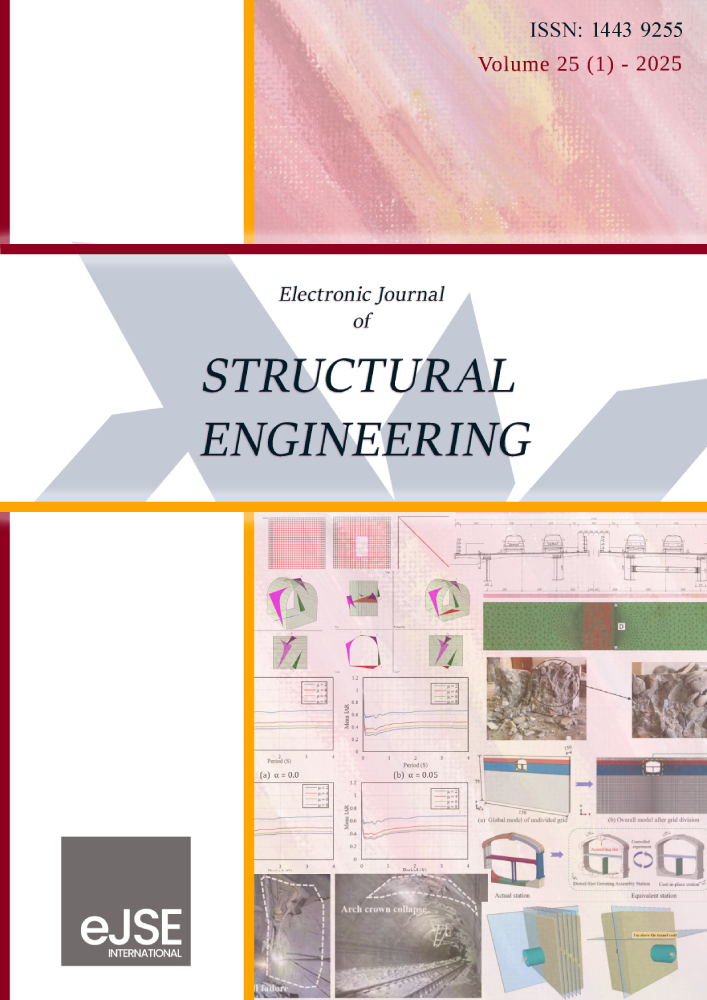The deformation and stress mechanism of water conveyance tunnel crossing strike-slip fault
DOI:
https://doi.org/10.56748/ejse.24716Keywords:
Fault-crossing tunnel , Fault dislocation, Deformation profile, Fortification length, Mechanical mechanismAbstract
Based on the Xianglushan water conveyance tunnel of the central Yunnan water diversion project, a large-scale finite element numerical model was established to study the lining deformation and failure mechanism of the Xianglushan water conveyance tunnel under the action of strike-slip faults. The lining damage law of the tunnel was revealed and the corresponding fortification position was proposed. The results show that the displacement distribution of cross-fault tunnel under the action of strike-slip fault generally presents an elongated S-shaped distribution. In the fault fracture zone, the tensile failure is prevented at the arch waist convex from the fault dislocation surface, and the compressive failure is prevented at the concave. The range of compressive and tensile strains is mainly concentrated in the fault fracture zone ± 0.6 times of the width of the fault zone. The shear damage of the top and bottom of the tunnel is relatively close. Therefore, combined with the strain distribution law of the left and right side walls of the tunnel and the maximum shear stress distribution law of the top and bottom of the tunnel, it is considered that the left and right side walls located in the fault fracture zone should prevent tensile and compressive failure, and the top and bottom of the tunnel should prevent shear failure. The results of this study can provide a theoretical reference for the key vulnerable parts of the tunnel.
Downloads
References
MEI X, SHENG Q, CUI Z, et al. Effect of Near-Fault Pulsed Ground Motions on Seismic Response and Seismic Performance to Tunnel Structures [J]. Shock and Vibration, 2021, 2021: 1-18. DOI: https://doi.org/10.1155/2021/9999007
SUN B, ZHANG S, DENG M, et al. Inelastic dynamic response and fragility analysis of arched hydraulic tunnels under as-recorded far-fault and near-fault ground motions [J]. Soil Dynamics and Earthquake Engineering, 2020, 132. DOI: https://doi.org/10.1016/j.soildyn.2020.106070
YANG Y, YU H, YUAN Y, et al. 1 g Shaking table test of segmental tunnel in sand under near-fault motions [J]. Tunnelling and Underground Space Technology, 2021, 115. DOI: https://doi.org/10.1016/j.tust.2021.104080
SHEN Y S, WANG Z Z, YU J, et al. Shaking table test on flexible joints of mountain tunnels passing through normal fault [J]. Tunnelling and Underground Space Technology, 2020, 98. DOI: https://doi.org/10.1016/j.tust.2020.103299
YANG H, LIU C, JIANG X, et al. Shaking Table Test and Numerical Simulation for Dynamic Response of Shallow-Buried Bias Double-Arch tunnel [J]. Geotechnical and Geological Engineering, 2020, 38(4): 3915-29. DOI: https://doi.org/10.1007/s10706-020-01267-9
ZHU D, ZHU Z, ZHANG C, et al. Shaking Table Test on the Tunnel Dynamic Response under Different Fault Dip Angles [J]. Symmetry, 2021, 13(8). DOI: https://doi.org/10.3390/sym13081375
BAZIAR M H, NABIZADEH A, JUNG LEE C, et al. Centrifuge modeling of interaction between reverse faulting and tunnel [J]. Soil Dynamics and Earthquake Engineering, 2014, 65: 151-164. DOI: https://doi.org/10.1016/j.soildyn.2014.04.008
BAYATI M, KHADEMI HAMIDI J. A case study on TBM tunnelling in fault zones and lessons learned from ground improvement [J]. Tunnelling and Underground Space Technology, 2017, 63: 162-70. DOI: https://doi.org/10.1016/j.tust.2016.12.006
Ryan H F, Parsons T, Sliter R W. Vertical tectonic deformation associated with the San Andreas fault zone offshore of San Francisco, California[J]. Tectonophysics, 2008, 457(3-4): 209-223. DOI: https://doi.org/10.1016/j.tecto.2008.06.011
Durukal E. Critical evaluation of strong motion in Kocaeli and Du¨zce (Turkey) earthquakes[J]. Soil Dynamics and Earthquake Engineering, 2002(22): 589–609. DOI: https://doi.org/10.1016/S0267-7261(02)00014-3
Wang W, Wang T, Su J, et al. Assessment of damage in mountain tunnels due to the Taiwan Chi-Chi Earthquake[J]. Tunnelling and Underground Space Technology, 2001, 16(3): 133-150. DOI: https://doi.org/10.1016/S0886-7798(01)00047-5
P. Chen, P. Geng, J. Chen, W. Gu, the seismic damage mechanism of Daliang tunnel by fault dislocation during the 2022 Menyuan Ms6.9 earthquake based on unidirectional velocity pulse input, Engineering Failure Analysis. 145(2023), 107047. DOI: https://doi.org/10.1016/j.engfailanal.2023.107047
UCKAN E, AKBAS B, SHEN J, et al. A simplified analysis model for determining the seismic response of buried steel pipes at strike-slip fault crossings [J]. Soil Dynamics and Earthquake Engineering, 2015, 75(55-65. DOI: https://doi.org/10.1016/j.soildyn.2015.03.001
AN S, TAO L J, HAN X C, et al. Application of two-level design method on subway tunnel crossing active fault: a case study on Urumqi subway tunnel intersected by reverse fault dislocation [J]. Bulletin of Engineering Geology and the Environment, 2021, 80(5): 3871-84. DOI: https://doi.org/10.1007/s10064-021-02164-y
ZHONG Z, WANG Z, ZHAO M, et al. Structural damage assessment of mountain tunnels in fault fracture zone subjected to multiple strike-slip fault movement [J]. Tunnelling and Underground Space Technology, 2020, 104 DOI: https://doi.org/10.1016/j.tust.2020.103527
KUN M, ONARGAN T. Influence of the fault zone in shallow tunneling: A case study of Izmir Metro Tunnel [J]. Tunnelling and Underground Space Technology, 2013, 33: 34-45. DOI: https://doi.org/10.1016/j.tust.2012.06.016
TRIFUNAC M D, TODOROVSKA M I. 1971 San Fernando and 1994 Northridge, California, earthquakes: did the zones with severely damaged buildings reoccur? [J]. Soil Dynamics and Earthquake Engineering, 2004, 24(3): 225-39. DOI: https://doi.org/10.1016/j.soildyn.2003.11.006
ROY N, SARKAR R. A Review of Seismic Damage of Mountain Tunnels and Probable Failure Mechanisms [J]. Geotechnical and Geological Engineering, 2016, 35(1): 1-28. DOI: https://doi.org/10.1007/s10706-016-0091-x
FUKUYAMA H, SUGANO S. Japanese seismic rehabilitation of concrete buildings after the Hyogoken-Nanbu Earthquake [J]. Cement & Concrete Composites, 2000, 22: 59-79. DOI: https://doi.org/10.1016/S0958-9465(99)00042-6
WANG W, WANG T, SU J, et al. Assessment of damage in mountain tunnels due to the Taiwan Chi-Chi Earthquake [J]. Tunnelling and Underground Space Technology, 2001, 16(3): 133-50. DOI: https://doi.org/10.1016/S0886-7798(01)00047-5
SHEN Y, GAO B, YANG X, et al. Seismic damage mechanism and dynamic deformation characteristic analysis of mountain tunnel after Wenchuan earthquake [J]. Engineering Geology, 2014, 180: 85-98. DOI: https://doi.org/10.1016/j.enggeo.2014.07.017
KIANI M, AKHLAGHI T, GHALANDARZADEH A. Experimental modeling of shallow segmental tunnels in alluvial affected by normal faults [J]. Tunnelling and Underground Space Technology, 2016, 51: 108-19. DOI: https://doi.org/10.1016/j.tust.2015.10.005
LIN M L, CHUNG C F, JENG F S, et al. The deformation of overburden soil induced by thrust faulting and its impact on underground tunnels [J]. Engineering Geology, 2007, 92(3-4): 110-132. DOI: https://doi.org/10.1016/j.enggeo.2007.03.008
LIU X Z, LI X F, SANG Y L, et al. Experimental study on normal fault rupture propagation in loose strata and its impact on mountain tunnels [J]. Tunnelling and Underground Space Technology, 2015, 49: 417-25. DOI: https://doi.org/10.1016/j.tust.2015.05.010
YAO C, HE C, TAKEMURA J, et al. Active length of a continuous pipe or tunnel subjected to reverse faulting [J]. Soil Dynamics and Earthquake Engineering, 2021, 148. DOI: https://doi.org/10.1016/j.soildyn.2021.106825
ZENG G, GENG P, GUO X, et al. An anti-fault study of basalt fiber reinforced concrete in tunnels crossing a stick-slip fault [J]. Soil Dynamics and Earthquake Engineering, 2021, 148. DOI: https://doi.org/10.1016/j.soildyn.2021.106687
Wang T, Geng P, Li P, et al. Deformation and failure of overburden soil subjected to normal fault dislocation and its impact on tunnel[J]. Engineering Failure Analysis, 2022, 142: 106747. DOI: https://doi.org/10.1016/j.engfailanal.2022.106747
VAZOURAS P, KARAMANOS S A, DAKOULAS P. Finite element analysis of buried steel pipelines under strike-slip fault displacements [J]. Soil Dynamics and Earthquake Engineering, 2010, 30(11): 1361-76. DOI: https://doi.org/10.1016/j.soildyn.2010.06.011
Zhou G, Sheng Q, Cui Z, et al. Investigating the deformation and failure mechanism of a submarine tunnel with flexible joints subjected to strike-slip faults[J]. Journal of Marine Science and Engineering, 2021, 9(12): 1412. DOI: https://doi.org/10.3390/jmse9121412
Downloads
Published
How to Cite
Issue
Section
License
Copyright (c) 2025 Guangyue Ran

This work is licensed under a Creative Commons Attribution 4.0 International License.







